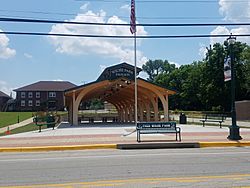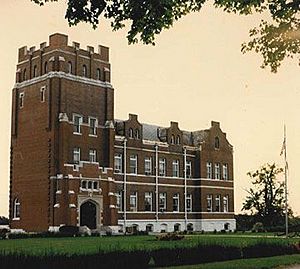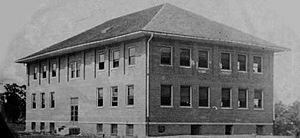Simpsonville, Kentucky facts for kids
Quick facts for kids
City of Simpsonville
|
|
|---|---|

Pavilion at Fred Wiche Park In Simpsonville, Kentucky
|
|
| Nickname(s):
American Saddlebred Horse Capital of the World
|
|

Location of Simpsonville in Shelby County, Kentucky.
|
|
| Country | United States |
| State | Kentucky |
| County | Shelby |
| Incorporated | 1833 |
| Named for | John Simpson |
| Government | |
| • Type | City Commission |
| Area | |
| • Total | 2.38 sq mi (6.15 km2) |
| • Land | 2.35 sq mi (6.09 km2) |
| • Water | 0.02 sq mi (0.06 km2) |
| Elevation | 771 ft (235 m) |
| Population
(2020)
|
|
| • Total | 2,990 |
| • Estimate
(2022)
|
3,028 |
| • Density | 1,270.72/sq mi (490.71/km2) |
| Time zone | UTC−5 (Eastern (EST)) |
| • Summer (DST) | UTC−4 (EDT) |
| ZIP code |
40067
|
| Area code(s) | 502 |
| FIPS code | 21-70752 |
| GNIS feature ID | 2405466 |
| Interstates | |
Simpsonville is a city in Shelby County, Kentucky, in the United States. It is located about 8 miles west of Shelbyville, Kentucky and 23 miles east of Louisville. The city is situated along U.S. 60. In 2010, the population was 2,484 people.
Contents
History of Simpsonville
Early Beginnings
Simpsonville was first planned in 1816 by Isaac Watkins. It got its first post office in 1821. The city was officially formed in 1833. It was named after Captain John Simpson. He was from Virginia and represented Shelby County in the Kentucky House of Representatives. Captain Simpson died in the War of 1812.
By 1825, Simpsonville became a busy stagecoach town. It was one of the largest stops between Shelbyville and Louisville. Stagecoaches on the Midland Trail would stop here to change horses or let travelers rest. The Old Stone Inn was a popular place for travelers to stay. It is the second oldest stone building in the county and is still standing today.
For many years, Simpsonville was a farming community. Most people earned money from dairy products, tobacco, cattle, and hogs. This was because the soil was very rich and good for farming. It had a lot of limestone and red clay. Later, this farming history helped the town get its nickname: 'American Saddlebred Horse Capital of the World'.
Civil War Events
In January 1865, a group of about 80 soldiers from the 5th United States Colored Cavalry were moving 900 Federal cattle. They were going from Camp Nelson to a market in Louisville. They set up camp in Simpsonville.
On the morning of January 25, they were attacked by Confederate guerrillas. These were led by Henry Magruder. The guerrillas attacked from behind. They killed 22 Union soldiers and injured more than 20 others. Some of the soldiers were killed even after trying to surrender. No guerrillas were reported injured.
The Union army in Louisville did not respond for three days. The people of Simpsonville had to care for the wounded soldiers. Later, the injured were moved to a hospital in Jeffersonville, Indiana. Four more soldiers died there. The people of Simpsonville buried the dead soldiers in two large graves. These graves later became part of an African American cemetery. One grave is now marked with a memorial along U.S. 60. Some of the soldiers who survived later became Buffalo Soldiers.
No guerrillas were ever punished for this attack. However, Henry Magruder was later tried and found guilty of other murders. He was sentenced to death by a military court. He was executed in Louisville on October 20, 1865.
After the Civil War and 20th Century Growth
After the Civil War, Simpsonville remained a small village. It had about 200 to 300 residents. It was a center for schools and churches. In 1910, the Louisville & Eastern Railroad connected Simpsonville to Louisville in the west and Shelbyville in the east. This was an interurban railroad, which is like a streetcar system that connects cities. The Louisville and Interurban Railroad bought this line in 1911 and ran it until 1934.
After World War I, the Midland Trail became U.S. 60. This gave Simpsonville a direct link to the U.S. Highway System. Simpsonville's population started to grow after World War II. The completion of Interstate 64 in 1965 made it easy to travel to Louisville. This led to many new homes, factories, warehouses, and shops being built in Simpsonville.
Geography
Simpsonville covers a total area of about 1.3 square miles (3.4 km2). Most of this area, about 1.3 square miles (3.4 km2), is land. A small part, about 0.04 square miles (0.10 km2) (1.50%), is water.
Education
In its early days, Simpsonville had several one-room schools. These included Professor John W. Adams' school in the 1850s and Jordans Fairview Academy from 1868 to 1880. By 1895, there were four private schools. The first public high school, Simpsonville High School, was built in 1912.
Over the next few decades, this high school combined with Todd's Point in 1940 and Finchville High School in 1950. Simpsonville High School closed in 1958. This happened when Shelby County decided to combine its school system. The building then became Simpsonville Elementary School.
Today, students in Simpsonville attend schools in the Shelby County Public School system. High school students go to Martha Layne Collins High School in Shelbyville. There is also one private school, Corpus Christi Academy, which serves all grades.
After the Civil War, schools in Kentucky were separated by race. African-American children in Simpsonville attended Simpsonville School and Lincoln Model School. Simpsonville was also home to the Lincoln Institute. This was a boarding school for African American students, founded in 1912. Berea College built it because of the Day Law. This law forced all public and private schools to be segregated. The Lincoln Institute offered both high school and job training. It closed in 1966 because fewer students enrolled. This was due to the Brown v. Board of Education ruling, which ended school segregation. Today, the former school grounds are now the Whitney M. Young, Jr. Job Corps Training Center.
Population Information
| Historical population | |||
|---|---|---|---|
| Census | Pop. | %± | |
| 1830 | 77 | — | |
| 1850 | 225 | — | |
| 1860 | 169 | −24.9% | |
| 1870 | 239 | 41.4% | |
| 1880 | 253 | 5.9% | |
| 1890 | 290 | 14.6% | |
| 1900 | 203 | −30.0% | |
| 1910 | 185 | −8.9% | |
| 1920 | 189 | 2.2% | |
| 1930 | 181 | −4.2% | |
| 1940 | 220 | 21.5% | |
| 1950 | 247 | 12.3% | |
| 1960 | 220 | −10.9% | |
| 1970 | 628 | 185.5% | |
| 1980 | 642 | 2.2% | |
| 1990 | 907 | 41.3% | |
| 2000 | 1,281 | 41.2% | |
| 2010 | 2,484 | 93.9% | |
| 2020 | 2,990 | 20.4% | |
| 2022 (est.) | 3,028 | 21.9% | |
| U.S. Decennial Census | |||
In 2010, the census showed that 2,484 people lived in Simpsonville. There were 935 households and 672 families. The population density was about 980.9 inhabitants per square mile (378.7/km2). There were 935 housing units.
The people living in the city were mostly White (89.89%). There were also African American (6.80%), Native American (0.52%), and Asian (2.09%) residents. About 2.86% were from other races, and 2.13% were from two or more races. Hispanic or Latino people made up 8.98% of the population.
Out of 935 households, 40.7% had children under 18 living with them. About 53.9% were married couples. The average household had 2.66 people, and the average family had 3.17 people.
The population was spread out by age. About 30.6% were under 18. About 32.3% were between 25 and 44 years old. The median age was 33.3 years.
See also
 In Spanish: Simpsonville (Kentucky) para niños
In Spanish: Simpsonville (Kentucky) para niños




